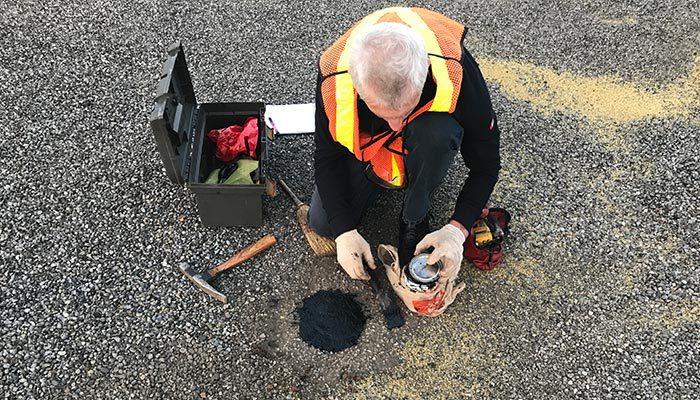There are many variables that go into determining how to design and price a roof replacement. But how do you go about determining those variables. One of the most critical steps that will help a roofing contractor or designer develop a proper plan for any roofing work is performing a core cut of the existing roof.
What is a roof core cut?
Simply put, a core sample is when a consultant takes a small cross section out of the roof assembly to determine the overall roof system composition.
But cutting into your roof can sound like a bad idea. Usually you are trying to avoid punctures and cuts to your roof system. But like doctors, roofing consultants are experts and know how to perform “roof surgery” and patch up the roof without doing any harm.
Why take a core sample?
Whether one is taking core samples for the purpose of evaluation or design, one of the primary purposes is material identification. The inspector observes and documents the composition of the roof membrane, cover board, insulation, vapour/air retarder, thermal barrier and roof deck layers, thicknesses, and method of attachment for each layer. With multi-ply bitumen roof systems, the type of bitumen and number of plies can often be determined through core sampling. With single-ply membranes, particularly thermoplastic, the colour or markings on the underside of the roof membrane can sometimes provide approximate age of the roof membrane.
The method attachments of the various membrane and insulation layers can be useful knowledge to have when devising repair and replacement recommendations. For example, whether the existing insulation can be salvaged and re-used during re-roofing may depend on how each layer is attached. Core sampling provides valuable information to assist in estimating the cost of a roof replacement.
Knowing the roof thickness helps determine the volume of demolition materials; and therefore, estimates the number of waste containers required. Knowing how a roof assembly is attached helps estimate how much effort removal will entail. Removal labor and waste hauling costs can total 25 percent of a re-roofing project.


What can a roof core cut tell us?
- Thickness – How thick is the current roof system?
- Layers – How many layers of roof or roof assemblies are in place?
- Composition – What are the different layers and weights of those layers?
- Slope – Is the slope on the roof system in the insulation or in the roof deck?
- Hazardous Materials – Is there a potential for hazardous materials (e.g. asbestos) in the assembly which require further testing?
- Roof Deck – What is the roof deck; type, material, condition?
- Moisture – Is there water trapped in the roof assembly or on the deck?
Without these factors, proper specification and accuracy of pricing associated of a repair or replacement cannot be determined. Without an accurate design specification, professional roofing contractors cannot offer an accurate price. Basing price on assumptions without confirmed and accurate information leaves the roofer and customer open to a project where a roofer may cut corners to remain profitable on the project or issue change orders for “unforeseen” extras and charge the customer for the difference.
If building owners are seeking accurate pricing for roofing projects, it is in their best interest to insist that the consultant complete the necessary steps such as core analysis in order to gather sufficient information required to develop correct specifications for the project.
Using a qualified Toronto roofing consultant can significantly help with the design process and help eliminate problems. Contact SMC Group for more information at 905-218-3507

